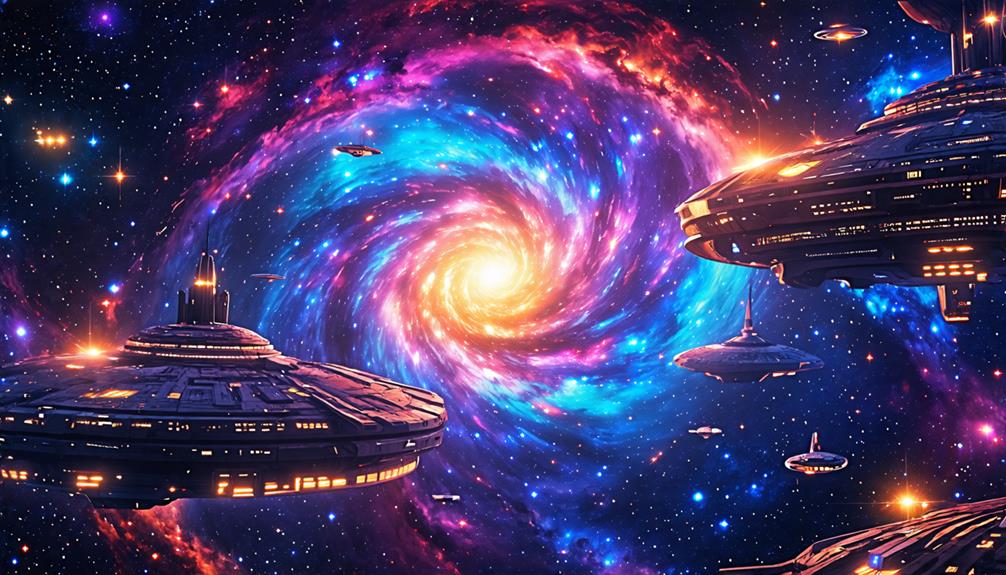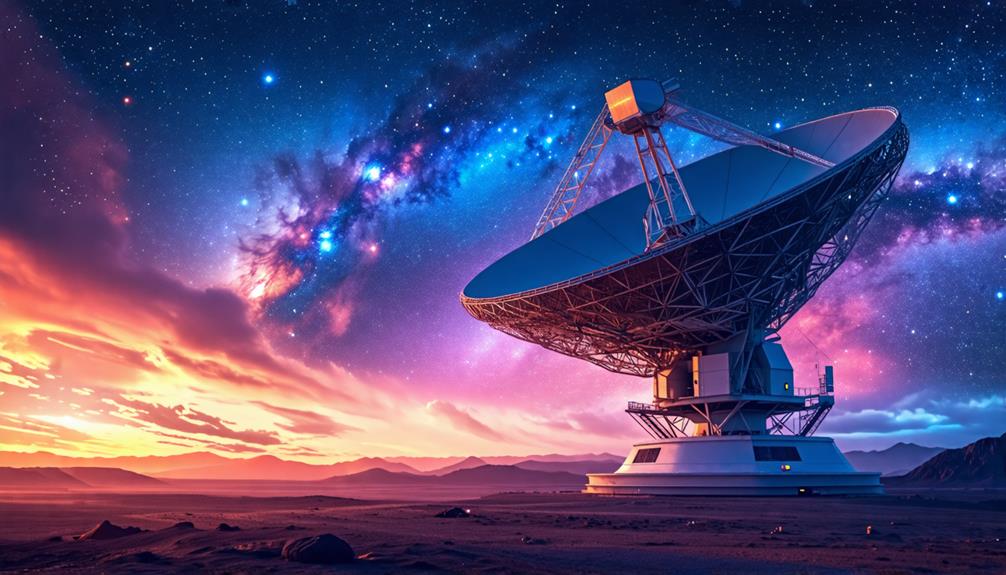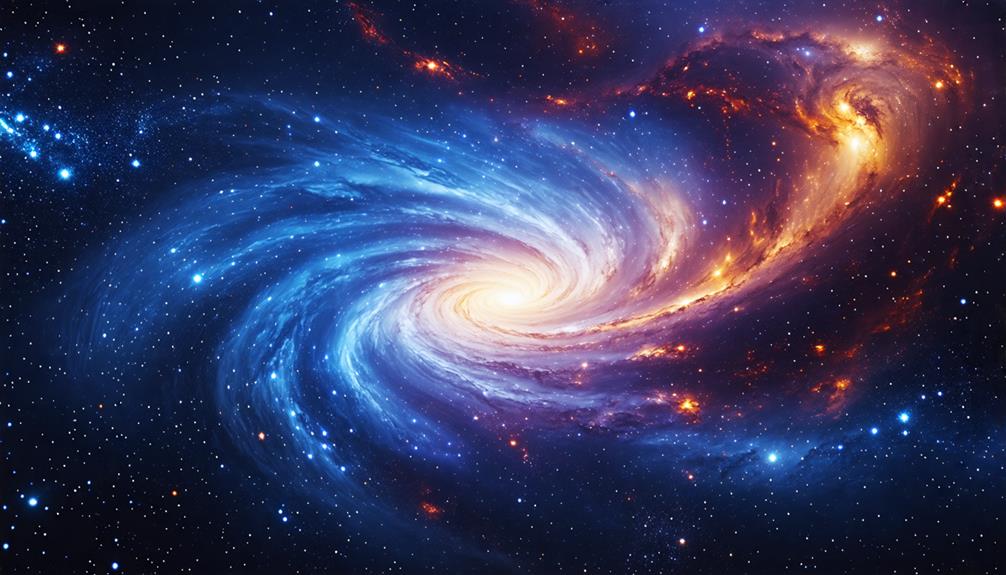5 Best Theories on Unexplained Cosmic Energy Sources
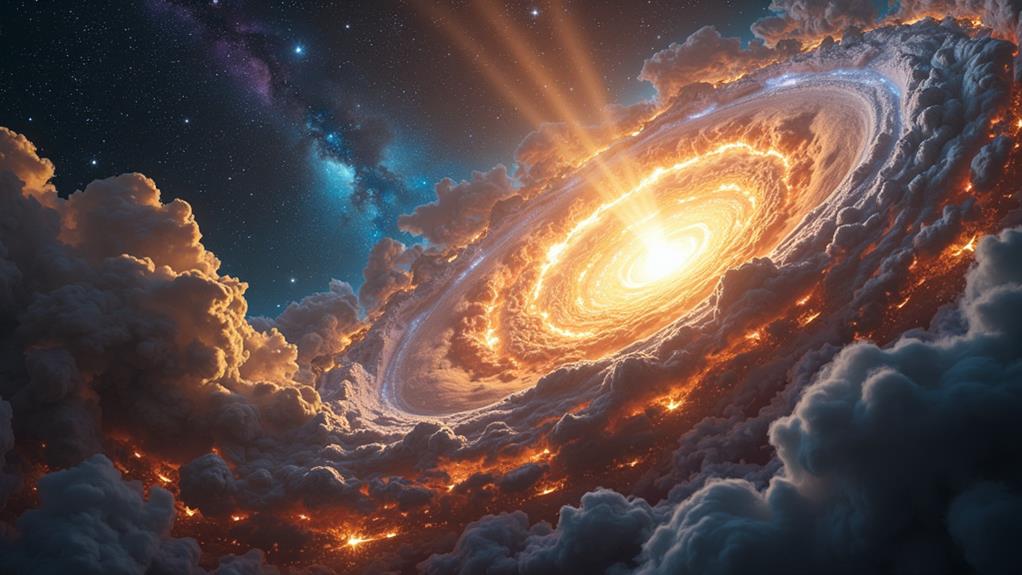
You're about to uncover five fascinating theories on enigmatic cosmic energy sources that intrigue scientists. Dark matter interactions suggest invisible particles make up 27% of the universe, affecting cosmic dynamics. Neutron star collisions, or kilonovae, release immense energy and gravitational waves. Supernova explosions briefly outshine galaxies and disperse heavy elements. Gravitational waves from merging black holes offer insights into dark matter and dark energy. Particle acceleration, driven by supernova remnants, neutron stars, and black holes, propels cosmic rays to near-light speeds. Each of these theories offers a peek into the mysterious forces shaping our universe. Curious to learn more?
Key Takeaways
- Dark Matter Annihilation: Theoretical interactions between dark matter particles may release significant energy, potentially explaining certain cosmic energy sources.
- Neutron Star Mergers: Kilonovae from neutron star collisions generate immense energy, possibly accounting for some unexplained cosmic phenomena.
- Hypernovae: These extremely powerful supernovae release vast amounts of energy, contributing to enigmatic cosmic energy signatures.
- Gravitational Waves: Energy from merging massive celestial bodies, detected as gravitational waves, offers clues to hidden cosmic energy sources.
- Supermassive Black Hole Jets: Accretion disc jets around supermassive black holes accelerate particles, emitting high-energy cosmic rays.
Dark Matter Interactions
Imagine peering into the cosmos and realizing that over a quarter of its mass-energy content is something we can't even see—dark matter. This mysterious substance makes up about 27% of the universe, influencing gravitational effects we observe in galaxies and cosmic structures. Despite its invisibility to electromagnetic radiation, dark matter's interactions are essential in shaping the universe.
You might wonder how dark matter interacts with ordinary matter. Theories propose it operates through weak forces, with potential candidates like Weakly Interacting Massive Particles (WIMPs) and axions. These fundamental particles are hypothetical but vital in our quest to understand dark matter. Observational evidence, such as gravitational lensing, where the light from distant galaxies bends around dark matter's mass, hints at these elusive interactions.
Scientists are actively hunting for direct signs of dark matter. Experiments using the Large Hadron Collider and underground detectors aim to capture these particles or their interactions, offering insights into their properties and behaviors. The enigma of dark matter isn't just a cosmic curiosity; it's a frontier that could revolutionize our understanding of fundamental physics and the dynamics of the universe's evolution.
Neutron Star Collisions
Neutron star collisions, often referred to as kilonovae, are among the most powerful events in the cosmos, releasing energy equivalent to a billion suns in mere seconds. When two neutron stars merge, the energy emitted is staggering, creating conditions ripe for the formation of heavy elements like gold and platinum. This process, known as r-process nucleosynthesis, makes neutron star collisions a primary source of these elements in the universe.
You've probably heard of gravitational waves, the ripples in spacetime that were initially predicted by Einstein. Neutron star collisions are a major source of these waves. Observatories like LIGO and Virgo have detected these gravitational waves, giving us valuable insights into the properties of neutron stars and the fundamental nature of gravity. The 2017 event GW170817 was groundbreaking, as it was the inaugural time a neutron star merger was observed with both gravitational waves and electromagnetic signals across multiple wavelengths. This marked a significant milestone in multi-messenger astronomy.
Additionally, the energy released during these collisions can also lead to gamma-ray bursts, some of the most energetic explosions in the universe. Clearly, neutron star collisions are key players in the cosmic energy game.
Supernova Explosions
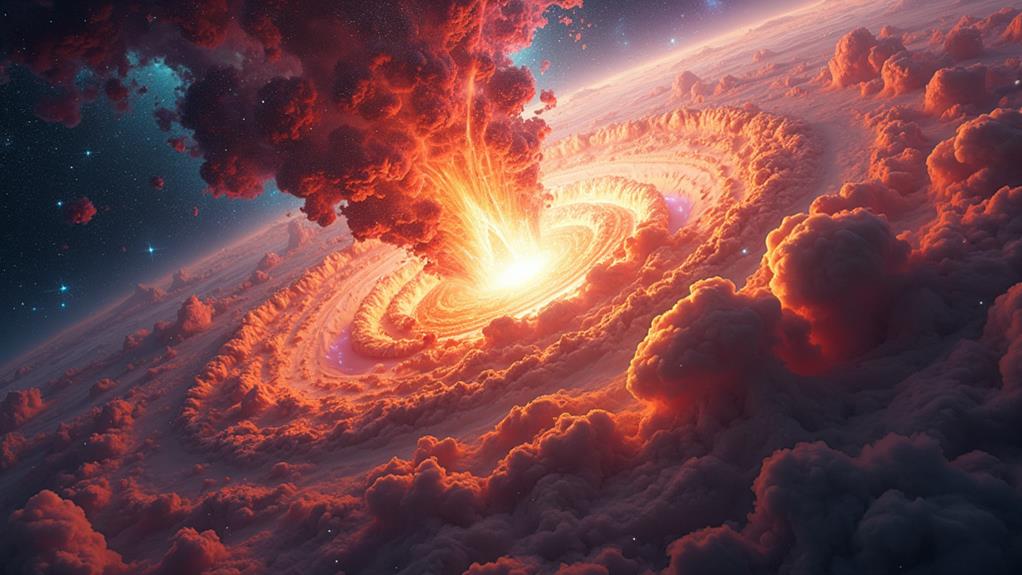
Supernova explosions rank among the most luminous and energetic events in the universe, briefly outshining entire galaxies. When a massive star collapses catastrophically, it releases an astounding amount of energy—about 10^44 joules—in just a few weeks, comparable to what our Sun will produce over its entire lifetime. Some supernovae, known as hypernovae, can release up to 100 times more energy. These explosions are crucial in dispersing heavy elements like gold and uranium into the interstellar medium, enriching the chemical makeup of the universe.
One fascinating aspect of supernova explosions is their role in cosmic ray acceleration. The shock waves generated by these explosions can propel particles to near-light speeds, contributing to the high-energy cosmic rays that we detect on Earth. This process not only adds to our understanding of cosmic rays but also underscores the immense power of these stellar events.
Moreover, the study of supernovae has greatly impacted our understanding of dark energy. Observations of distant supernovae revealed an accelerated expansion of the universe, a revelation that challenged existing cosmological models and led to the hypothesis of dark energy. Supernova explosions, consequently, are not just spectacular events; they're key to revealing the universe's deepest mysteries.
Gravitational Waves
Gravitational waves, ripples in spacetime caused by accelerating massive objects like colliding black holes or neutron stars, were initially directly detected by the LIGO observatory in 2015. These waves travel at the speed of light, and their revelation has transformed your understanding of the cosmos. Using laser interferometry, scientists can now measure these spacetime distortions, revealing cosmic events that were previously invisible.
When black holes merge, their immense gravitational pull generates gravitational waves, carrying vital information about their sources. These waves provide insights into the universe's structure and evolution, opening a new phase in astronomy. You can now study the cataclysmic collisions of neutron stars and the dynamics of binary black hole systems.
Gravitational waves also offer potential clues about dark matter and dark energy, which comprise about 95% of the universe's total mass-energy content. They carry information about the nature of gravity itself, possibly revealing secrets about these mysterious components. Ongoing experiments, like the Laser Interferometer Space Antenna (LISA), aim to detect lower frequency waves, expanding your ability to probe the universe's most energetic events and enhancing your understanding of the cosmos far beyond traditional cosmic rays observation.
Particle Acceleration
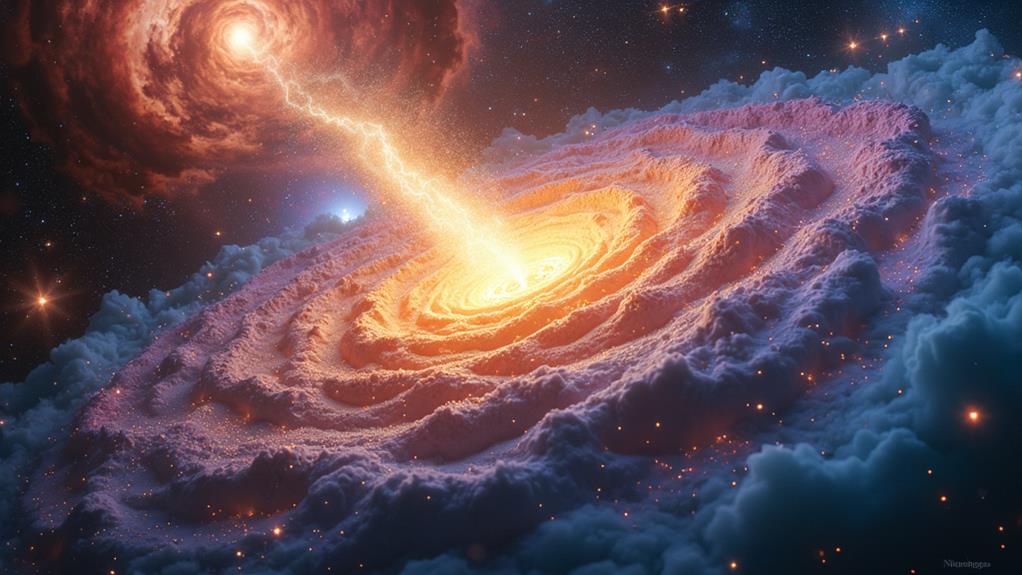
While gravitational waves offer a window into cosmic events like black hole mergers, particle acceleration provides another fascinating glimpse into the universe's high-energy phenomena. Cosmic rays come from numerous sources, and understanding their origins involves diving into the mechanisms of particle acceleration.
- Supernova Remnants: When stars explode, the resulting shock waves can accelerate particles to near-light speeds, creating high-energy cosmic rays.
- Neutron Stars: These dense stellar remnants, with their intense gravitational fields and rapid rotation, greatly contribute to particle acceleration.
- Supermassive Black Holes: At the centers of galaxies, gas swirling around these massive entities forms accretion discs, producing jets that can enhance particles to immense energies.
- Interstellar Magnetic Fields: Charged particles spiraling along magnetic lines gain considerable energy, advancing their acceleration.
Some cosmic rays, known as "Oh-My-God particles," reach astonishing energies over 300 million trillion electron volts (eV), far surpassing those produced by solar and stellar sources. Ongoing research aims to pinpoint specific astronomical events and environments that generate these highest-energy cosmic rays detected on Earth. Understanding particle acceleration in these contexts not only sheds light on cosmic rays but also helps you appreciate the dynamic and high-energy nature of our universe.
Frequently Asked Questions
What Is the Most Accurate Theory of the Universe?
Imagine the universe as a bubbling cauldron of mysteries. The most accurate theory right now combines quantum fluctuations, dark energy, and cosmic inflation. Quantum fluctuations might've sparked the Big Bang. Dark energy drives the universe's accelerated expansion, making up a mysterious 68%. Cosmic inflation explains the universe's rapid early growth. Together, these concepts form a cohesive picture, but they still leave room for new revelations.
What Is the Most Powerful Energy Source in the Universe?
You're wondering about the most powerful energy source in the universe. While supermassive black holes and gamma-ray bursts are incredibly potent, dark energy stands out. It drives the universe's accelerated expansion, fueled by dark matter, cosmic inflation, and quantum fluctuations. This mysterious force makes up about 68% of the universe's energy content, dwarfing other sources. Its exact nature remains one of the biggest puzzles in cosmology.
What Are the Three Major Theories of the Origin of the Universe?
You might find it fascinating that cosmic inflation expanded the universe faster than light in its initial fraction of a second. The three major theories of the origin of the universe are the Big Bang Theory, the Steady-State Universe Theory, and the Multiverse Theory. Cosmic inflation supports the Big Bang, while the Multiverse Theory suggests dark energy might vary across universes. Each theory offers unique insights into how everything began.
What Is the Most Powerful Cosmic Energy?
You're wondering about the most powerful cosmic energy, right? The "Oh-My-God particle" is a prime example, showcasing energy levels far beyond our particle accelerators. Cosmic radiation from blazars, supernova remnants, and quantum fluctuations in the universe all contribute. Dark matter interactions might also play a role in these extreme energies. Understanding these sources helps us grasp fundamental cosmic processes and the mysterious nature of dark matter.

